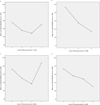Longitudinal associations between physical activity and depression scores in Swedish women followed 32 years
- PMID: 25865488
- PMCID: PMC4600636
- DOI: 10.1111/acps.12419
Longitudinal associations between physical activity and depression scores in Swedish women followed 32 years
Abstract
Objective: Physical activity is negatively associated with depressive symptoms. However, few studies consider dynamic associations of changes in physical activity and reciprocal relationships. This study aimed to perform comprehensive evaluations of relationships between physical activity and depression scores in women followed from mid- to late life.
Method: The Prospective Population Study of Women in Gothenburg, Sweden, provided repeated measures of self-reported physical activity and depressive symptoms between 1974 and 2005 (baseline N = 676, 84.5% response rate). Depressive symptoms were assessed using the Montgomery-Åsberg Depression Rating Scale, and physical activity was evaluated by the Saltin-Grimby Physical Activity Level Scale. Latent growth curve analyses were used to evaluate associations of change, and cross-lagged models were used to study the reciprocal relationship between physical activity and depression scores.
Results: At baseline, lower levels of physical activity were related to higher depression scores. Individuals with decreasing physical activity over time evidenced higher depression scores at 32-year follow-up. Higher average baseline depression score was related to declining levels of physical activity at subsequent examinations.
Conclusion: Reduced physical activity may be a long-term consequence of depression. It is important to address individual changes in physical activity and not merely absolute levels of physical activity in relationship to depression.
Keywords: change; depression scores; physical activity; women.
© 2015 John Wiley & Sons A/S. Published by John Wiley & Sons Ltd.
Figures
References
-
- Biddle SJ, Asare M. Physical activity and mental health in children and adolescents: a review of reviews. Br J Sports Med. 2011;45:886–895. - PubMed
-
- Josefsson T, Lindwall M, Archer T. Physical exercise intervention in depressive disorders: Meta-analysis and systematic review. Scand J Med Sci Sports. 2014;24:259–272. - PubMed
-
- Gallegos-Carrillo K, Flores YN, Denova-Gutierrez E, et al. Physical activity and reduced risk of depression: Results of a longitudinal study of Mexican adults. Health Psychol. 2013;32:609–615. - PubMed
-
- Aihara Y, Minai J, Aoyama A, Shimanouchi S. Depressive symptoms and past lifestyle among Japanese elderly people. Community Ment Health J. 2011;47:186–193. - PubMed
-
- Lindwall M, Larsman P, Hagger MS. The reciprocal relationship between physical activity and depression in older European adults: a prospective cross-lagged panel design using SHARE data. Health Psychol. 2011;30:453–462. - PubMed
Publication types
MeSH terms
Grants and funding
LinkOut - more resources
Full Text Sources
Other Literature Sources
Medical


